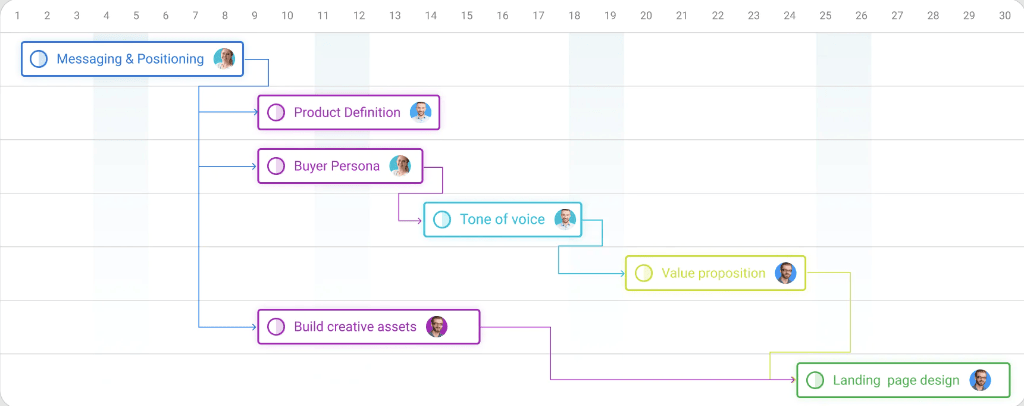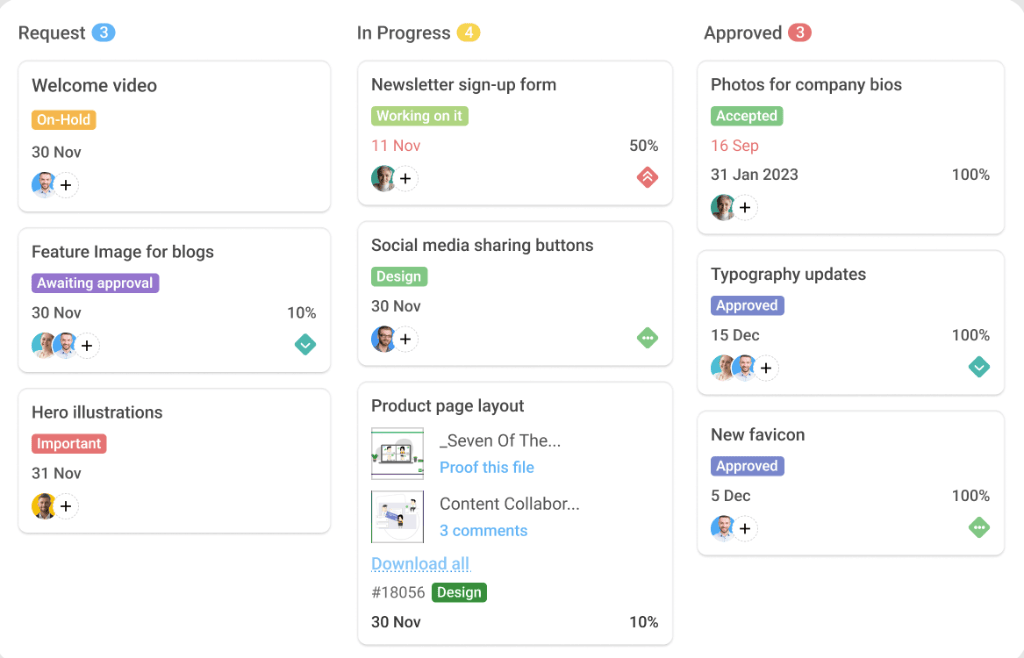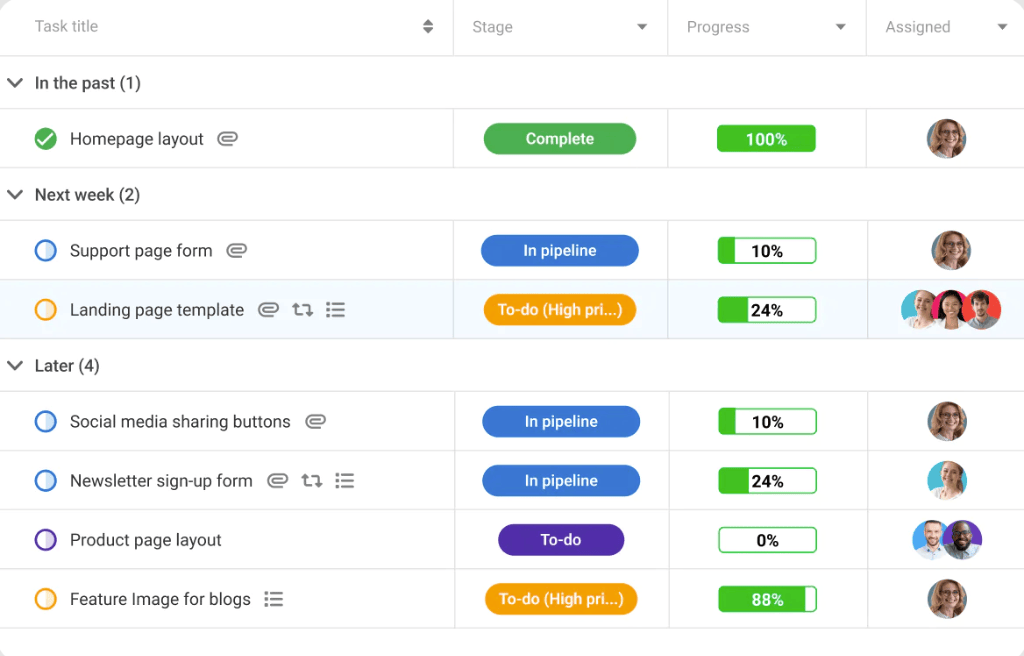Introduction
If there’s one thing that project managers want to get right from the start is workload management.
Overburden your team with tasks and you get – stress, low productivity, and potential burnout.
Smartly manage your team’s workload and it results in – quality work, improved productivity, high job satisfaction among employees, and successful project deliveries.
As a competent, skilled manager, you are expected not only to get results, but also to make sure your team is productive, motivated, and achieving the desired results.
Also, you are expected to keep your team’s workload under control to avoid overwork and burnout. So, how do you do it?
Effective workload management is easier said than done because workload can change at any moment.
As a manager, have you been caught in the following situations?
- Delayed task holding up the other interdependent task
- Certain employees feel overwhelmed by excessive tasks assigned to them
- Devs complaining about unrealistic sprint timeframes
While it’s true that each of the following situations can arise due to various factors, faulty workload management is a major contributor in each scenario listed above.
And now the good news. Smart workload management can solve the problem.
In this article, we’ll help managers to balance the team’s workload through well-thought-out strategies effectively.
Let’s get started!
What is workload management?
Workload management can be defined as a careful, well-planned process where managers delegate tasks to team members based on their skills, availability, and current workload.
Smart workload management also refers to fair, even distribution of tasks among employees so that no one is overloaded or underutilized with work. Everyone knows what they have to do, with whom (in case of group tasks), and deliver it by when (deadlines).
Workload management aims for:
- Make everyone feel satisfied with their job roles
- Produce high-quality results
- Create accurate project schedules
- Fair distribution of tasks
- Performance monitoring
In other words, workload management brings clarity to the job roles and responsibilities of individuals within the team. It is a fair and efficient distribution of work across your team, which helps to maximize their performance and increases job satisfaction. Your team will deliver quality work at a faster pace.
Say goodbye to burnout and hello to efficiency. Utilize ProofHub to get a complete overview of the workload on your team.
(No credit card required)
Why is workload management important?
I think that the definition of workload management gives us a strong indication of why it is important in this competitive business environment. Working professionals are under immense pressure to meet deadlines and deliver quality work to clients.
Workload management is important in today’s highly competitive business environment because of the following reasons.
Optimal utilization of resources
Your team might consist of hard-working, highly motivated people, but there’s a limit to what one can achieve in one day. Through effective workload management, you can ensure that your team members get the right work based on their skills and competency. This ensures the delivery of high-quality work, increased productivity, and faster work completion.
Also read: What is Resource Allocation? A Step-by-Step Guide
Reduces stress and avoids potential burnout
Stress, anxiety, and depression cost the global economy around $1 trillion in lost productivity. When people are assigned tasks that do not match their skills or are overloaded with excessive work, they struggle to cope and constantly feel stressed out. Good workload management allows managers to optimize the workload, which results in a fair distribution of work among employees. As a result, employees’ health improves and they are happier and more productive.
Increased productivity
Every business yearns for more productivity and workload management makes it possible. Fair distribution of workload translates to reduced workload and increased productivity as your team members work with a positive attitude, realizing their potential, and achieving set goals quickly.
Eliminates vagueness surrounding job roles & responsibilities
You cannot expect your team to be productive when there’s confusion surrounding job roles and responsibilities; no one has a clear idea of what to work on and when. Workload management brings clarity to task allocation as everyone knows what they have to work on when to start it, and what is the due date. It encourages transparency within the team and greatly reduces task-related conflicts among team members.
Improves employee retention rate
Achievers Workforce Institute’s 2021 Engagement and Retention Report found that 23% of employees would stay in their current jobs due to the better work-life balance they get. Workload management encourages better work-life balance as employees do not feel overworked and under constant severe pressure. It is a fact that happy, productive employees are less likely to leave the organization as compared to stressed, burnt-out people.
Top 5 tips for managers to take for effective workload Management
Now, as many project managers have found, workload management is easier said than done. Team leaders have to maintain a fine balance between tasks, projects, deadlines, and skills.
You have to make sure that your team members are working on productive work that delivers value rather than performing things that take a whole lot of time without yielding anything valuable.
Here are the tips with an action plan that can help you with effective workload management to get more done in less time.
1. Analyze and plan tasks
The workload management process starts with task analysis and planning. List down all projects and tasks your team is working on, and create an estimated time the project will take to complete. Compare your team’s capabilities with the efforts needed to complete the project.
Creating a project timeline using a Gantt chart is the most effective way to plan and visualize how different phases of the project align together.
Here’s how you arrange tasks in the Gantt chart.
- Add task lists and tasks to the Gantt chart
- Arrange them in a way you want them to be performed and visualize them in a timeline view
- Assign tasks or subscribe the entire task list to one or multiple people
- Set task dependencies
- Track tasks progress with percentage
- Drag and drop tasks in the chart to change their start dates, due dates, or even duration

| Additional Tip: Deploy task management software for even distribution, scheduling, and tracking of tasks from one place. |
2. Resource availability and assign tasks accordingly
Once you have created a project timeline and set the sequence of tasks, you should now check the availability of resources and assign tasks accordingly. Managers should have a clear picture of resource availability to keep everyone’s tasks balanced and manageable. Using top-rated task management software can help you achieve this challenging feat as you can allocate, assign, and track tasks easily.
Here are some tips to help you maximize resource utilization.
- Break large tasks into smaller, manageable subtasks for easy management of workflows
- Create to-do lists for team members to give them a clear direction of what needs to be done
- Assign individual or group tasks.
- Set realistic time estimates, start, and due dates to define the amount of time in which a particular task is to be completed.
- Make sure the right employees are assigned to every task or project.

| Additional Tip: Ideally, resource allocation should be an early project consideration, during the planning phase. |
Manage your team’s workload with ProofHub Custom workflows.
(No credit card required)
3. Set clear expectations or priorities
Once you’ve created and assigned tasks to your team members, it’s time for managers to set things straight – lay down clear expectations and set realistic, achievable deadlines. It means telling your direct reports what you want from them in clear terms, merely sharing the job description will not do.
Here are some tips for managers to set expectations the right way.
- Define ‘what’ are your expectations from your direct reportees, ‘how’ they can achieve those expectations, and ‘what’ is the purpose of your expectations from your team members.
- Set expectations that work to the strengths of your team members. Understand what areas they excel in, their behavioral triggers, and their motivation.
- Communicate clearly, early, and frequently through different communication mediums (texting, chat, video conferencing, face-to-face, and phone calls) to send your message timely and effectively.
- Don’t dictate your reportees but encourage two-way conversation where you discuss each other’s requirements and expectations.
- Assess your employees’ performance and attitude regularly through one-on-one meetings. Your employees should not feel micromanaged, dictated to, or unhappy.
| Additional Tip: Before you set expectations, know the employee’s skill set and what they can accomplish. |
4. Follow up with employees consistently and adjust as needed
Even well-planned projects can meet unexpected roadblocks that can deviate from track. Managers need to act quickly and make real-time adjustments to make sure deadlines are met. You should set regular one-on-one check-ins with them regularly to find out if team members are satisfied or overwhelmed with the tasks at hand.
If a team member expresses their concern about having too many tasks in hand, you can alleviate their workload. For that, you’ll have to check if someone has less work to do than usual. By doing this, managers can balance the workload and show their team members that they care about their workload concerns and stress level at work.
Here are some tips for managers for effective employee follow-up.
- Be an active listener
- Make notes during the session to avoid missing out on important points discussed with your employees
- Don’t make your one-on-one meetings centered around work only. You can include casual discussions and add some humor to help employees feel relaxed
- Sharing the agenda beforehand is very important
- Always wind up on a positive note
| Additional Tip: Let your employees choose the meeting place where they feel comfortable in saying things clear and loud |
5. Use the best team workload management tool
Imagine how easy and effortless it can get for you when you can see the progress of every task and what your team members are up to in a single Bird’s eye view. The use of a top-rated work management and team collaboration tool like ProofHub helps managers check resource availability, schedule and allocate tasks, and track them at every stage of the project.
As project teams juggle multiple projects simultaneously, workload management software helps managers simplify the process and take timely actions to avoid employee burnout and missing deadlines.

Here’s how ProofHub helps managers with fair and even distribution of work to make sure no one is overloaded.
- ProofHub’s inbuilt, effective task management software enables managers to divide large projects into smaller, manageable tasks and subtasks, and allocate these to the right people based on their skills and availability.
- Managers can use Gantt charts to create project schedules, set dependencies, track task progress, and view critical paths and overall project status.
- Managers can set time estimates, and start and due dates for different tasks to give a clear timeframe.
- Table view offers a simple and clear listview of all your to-dos. You can prioritize tasks, add labels, and attempt them accordingly.
- Set clear objectives by setting milestones. Users can check these milestones and share progress with team members.
- Communicate clearly with widely distributed team members through features like instant chat, discussion boards, real-time updates, and announcements.
- Online proofing feature allows managers and clients to give reviews and feedback for specific regions using markup tools, which allows teams to deliver high-quality, error-free work.
- Track overall progress with boards, Gantt charts, and Table view.
- The insightful reporting tool allows users to add consolidated information about their working status and projects.
| Additional Tip: Choose a workload management tool that offers a wide range of features, ease of usage, and competitive pricing. |
Recognized as a high performer for 2023 in g2, ProofHub provides you with a realistic picture of your team’s capacity to confidently plan and schedule project activity.
(No credit card required)
Conclusion
Managers must remember that unless their employees are relaxed and happy, they can’t deliver quality work. That’s why efficient workload management is one of the most vital skills for project managers to have in today’s dynamic, fast-paced work environment.
The tips mentioned above, and using the right work management and team collaboration tool, can help project managers with even and fair distribution of tasks among people while maintaining a fine balance between overutilization and underutilization of resources.
ProofHub, with its work management and team collaboration features, can help you and your team to consistently hit deadlines without feeling overwhelmed. You can start your 14-day free trial from here.
Also read:

